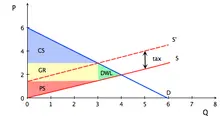Economics Terms A-Z
Cross Elasticity of Demand
Read a summary or generate practice questions using the INOMICS AI tool
The cross elasticity of demand (or cross-price elasticity of demand) ϵAB refers to the sensitivity of the demand for item A qA to changes in the price of item B pB:
\begin{equation*}\epsilon_{AB} = \frac{\Delta\mathit{q}_{A}}{\Delta\mathit{p}_{B}} = \frac{\frac{{dq}_{A}}{\mathit{q}_{A}}}{\frac{{dp}_{B}}{p_B}}\end{equation*}
In microeconomics, individuals' utility (or material well-being) is assumed to depend on their access to, or consumption of, bundles of items. It is also contingent on individuals seeking to maximize their utility.
The precise relationship between the consumption of particular items and an individual’s utility is determined by the person’s preferences. Individuals are constrained in their consumption by their budgets and by the prices of the items.
If the price of an item increases, then the individual’s ability to obtain utility through consumption of that item is reduced. It may be possible to obtain utility more efficiently through consumption of a different item instead. The extent to which this is possible depends on the substitutability of other items with the item whose price has increased.
For example, an individual may like to consume hazelnuts and peanuts. Ideally the individual likes to consume both types of nuts (due to diminishing marginal utility).
However, if the price of one nut type – say peanuts – increases, then the individual can afford fewer peanuts. This would lead them to reduce peanut consumption and replace some of this product with hazelnuts. Hazelnuts and peanuts are thus substitutes in consumption.
Note that the reverse is also true if the price of peanuts falls and becomes more affordable. The individual will then obtain utility more efficiently by reducing hazelnut consumption and increasing peanut consumption. This means that in the case of substitutes, the cross elasticity of demand is positive ϵHazelnutsPeanuts > 0.
The interrelationship between items is key in the cross elasticity of demand. Some items are consumed together as complements rather than as replacements or substitutes.
For example, fuel is required to power vehicles. If the price of either one of these items changes, demand for both goods will move in the same direction.
If the price of vehicles increases then demand for the vehicles will fall. Because of this the demand for the fuel that powers the vehicles will also fall. Likewise, if the price of fuel rises then demand for both fuel and vehicles will fall. So, in the case of complements, the cross elasticity of demand is negative ϵFuelVehicles < 0.
Other items have conceivably very little to do with each other. For example, if the price of yogurt changes then this would not be expected to affect the demand for smartphones. The cross elasticity of demand between these items should be close to zero ϵSmartphonesYogurt ≈ 0.
However, note that if an item that makes up a large or necessary part of individuals’ budgets becomes less affordable, people might buy fewer goods in general because they are relatively poorer. This will then lead indirectly to change in the demand for other seemingly unrelated items.
For example, if smartphones triple in price, people might decide they need smartphones but end up buying much less yogurt because they have less leftover money to spend. But, this still doesn’t mean that smartphones and yogurt are truly substitutes; there’s a different effect at play. See income elasticity of demand for details about this type of effect.
As with the standard price elasticity of demand for a single item, a cross elasticity of demand can be elastic (IϵABI ≥ 1), unit elastic (IϵABI = 1), inelastic (IϵABI < 1), perfectly inelastic (IϵABI = 0) or (in theory) perfectly elastic (IϵABI → ∞). This reflects the extent of the change in quantity demanded relative to a change in price.
Further reading
To better understand the difference between substitutes and complements and its importance for policy makers, read “Marijuana and Alcohol Evidence Using Border Analysis and Retail Sales Data” (2018). This paper from researchers Baggio, Chong and Kwon from the University of Connecticut and Georgia State University reflects on the effect of legalizing cannabis on the consumption of alcohol.
More generally, it has recently been reported that current cross-price elasticities are lower than previously estimated (Auer and Papies, Journal of the Academy of Marketing Science, 2019). The median estimate of ϵAB is about 0.1, implying typically only a small degree of substitutability between items. The authors mention firms’ focus on the development of brand loyalty as one reason why consumers may switch less between items than traditional economic theory would predict.
Good to know
The United States Department of Agriculture Economic Research Service provides a data tool to access estimates of price elasticities. This includes cross elasticities of demand, both for major commodities and countries (particularly the USA and China). The estimates are derived from research published by US academic and government sources.
-
- PhD Candidate Job
- Posted 2 weeks ago
Fully Funded PhD Positions in Economics, University of Lugano (USI), Switzerland
At Università della Svizzera italiana (University of Lugano) in Lugano, Switzerland
-
- Workshop, Conference
- Posted 6 days ago
Venice Summer Institute
Between 22 Jun and 25 Jun in Venice, Italy and Venice, Italy
-
- PhD Candidate Job
- Posted 1 week ago
Junior Researcher (doctoral student) in Economics and Global Health
At Kiel Institute for the World Economy (IFW) in Kiel, Germany













